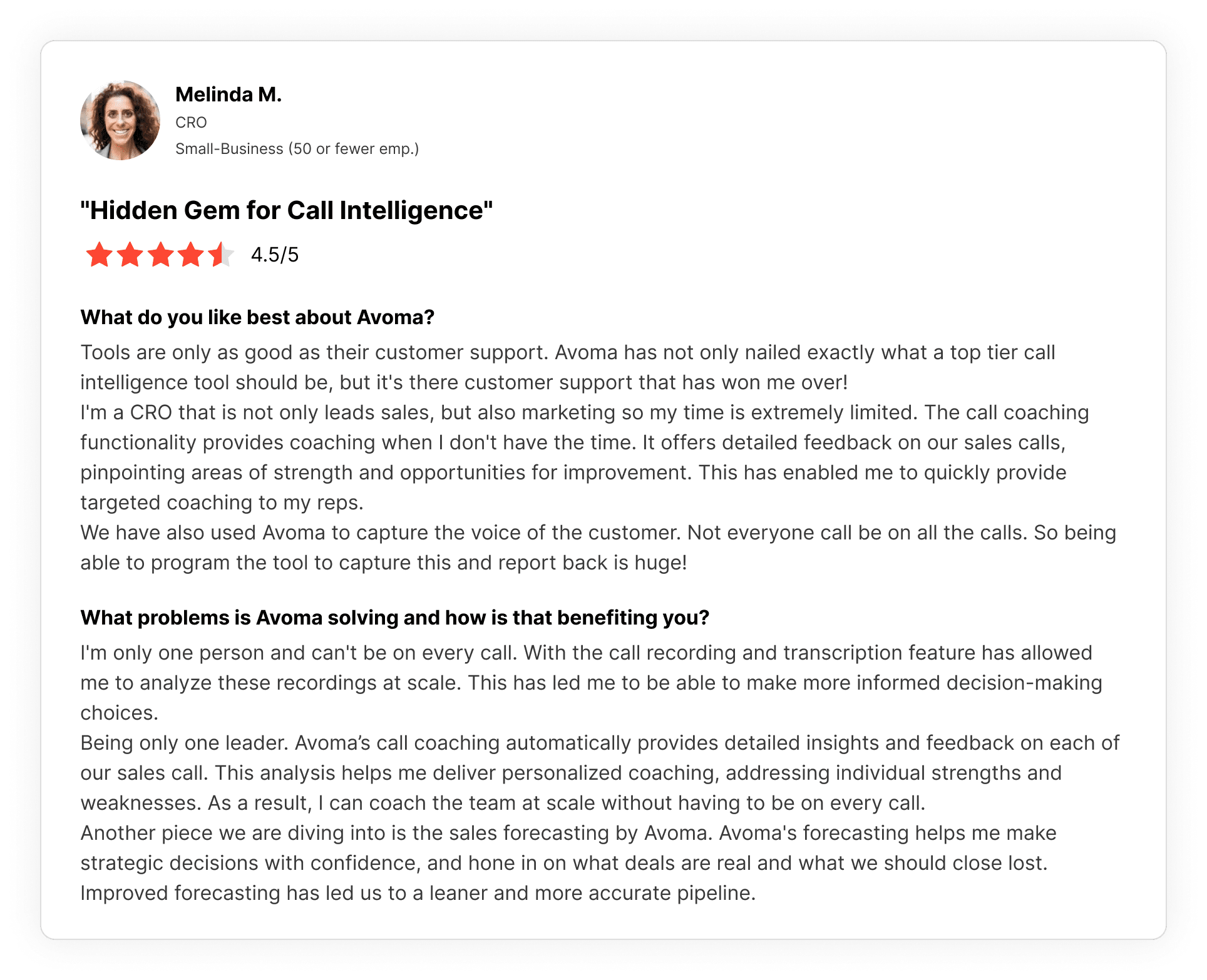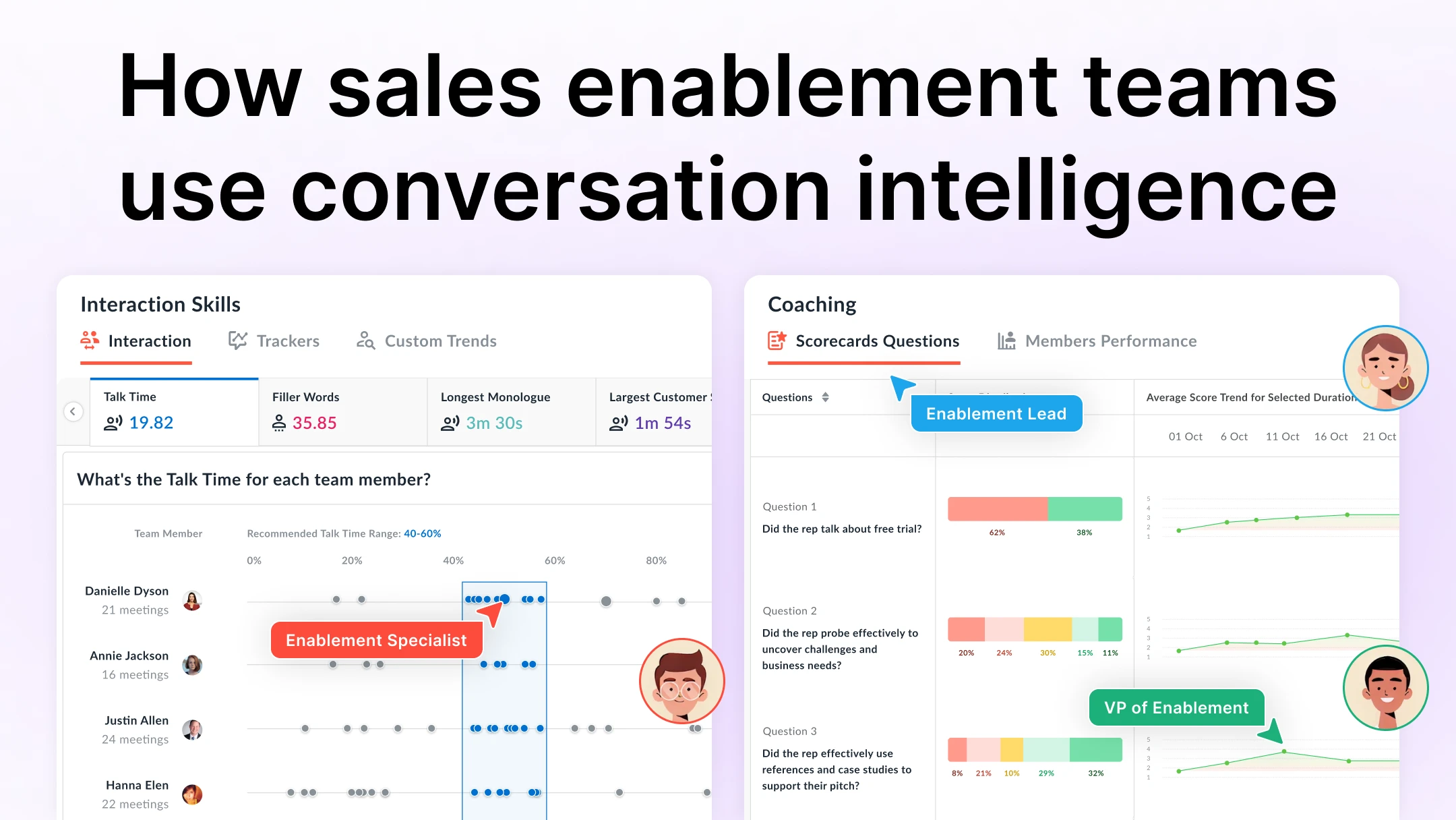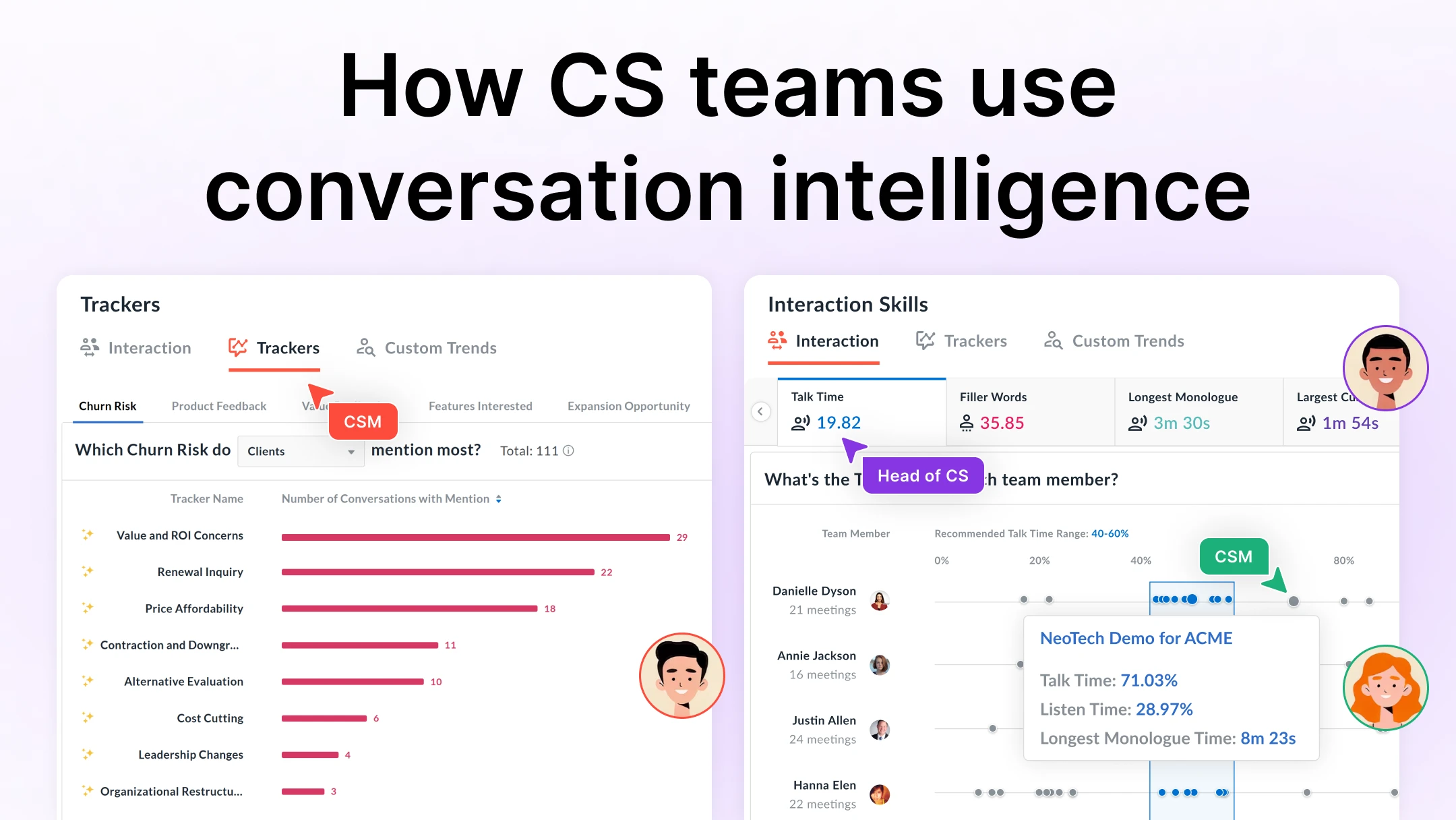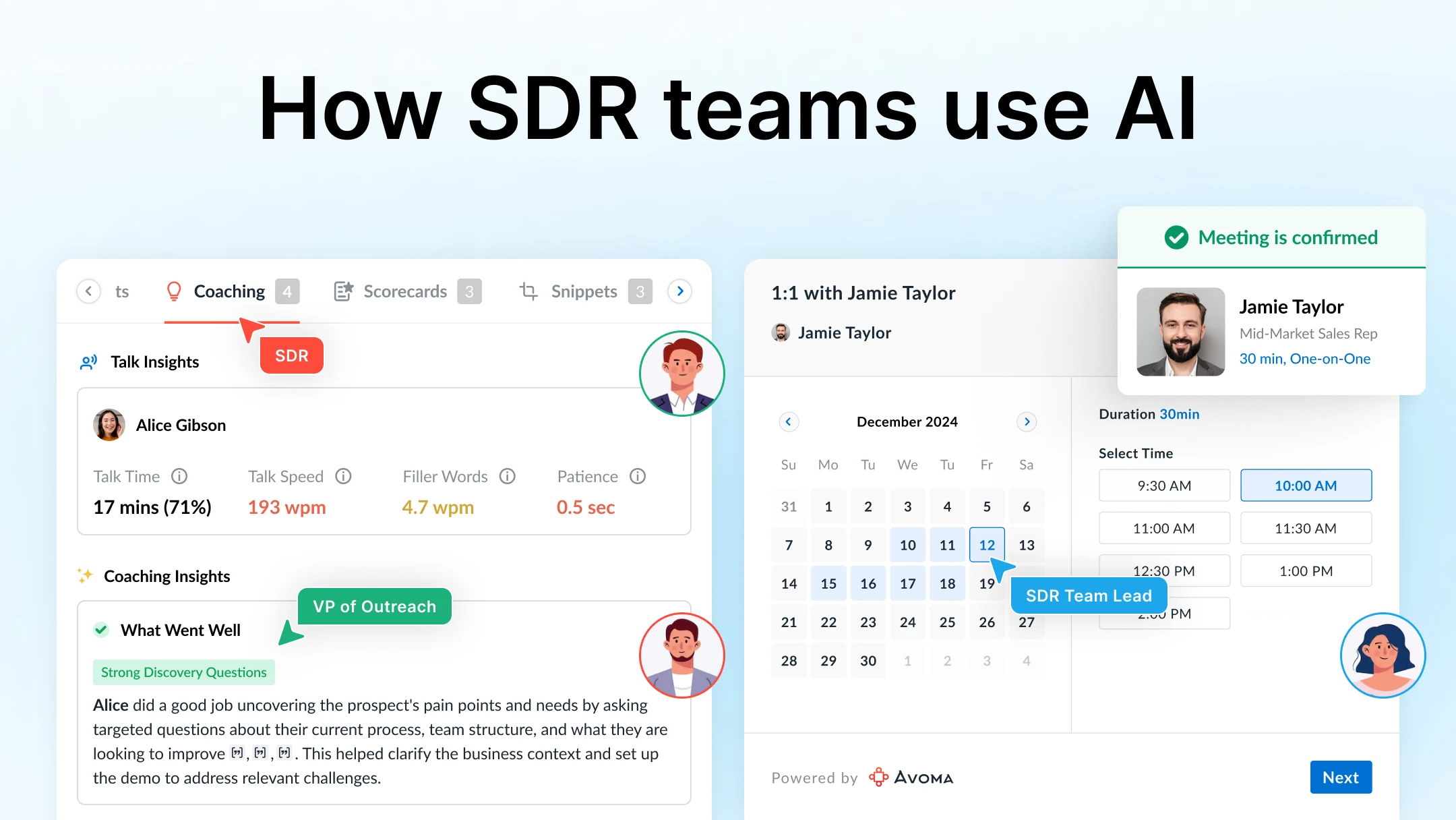How CROs use revenue intelligence to drive predictable growth
Table of Contents:

If I were a CRO today, I'd want one thing above all: Clarity.
Clarity on my forecast accuracy.
Clarity on how well sales, marketing, and customer success are aligned.
And clarity on what's truly driving revenue growth, not just what the CRM says is happening.
But let's be honest. That kind of clarity is hard to maintain when data lives in silos, meetings move faster than insights can be shared, and the "truth" about a deal depends on who you ask. Even the most seasoned CROs are surrounded by noise: inconsistent pipeline updates, incomplete customer data, and hours spent piecing together what's real.
That's where revenue intelligence changes the game.
It provides CROs with visibility across teams, enabling them to validate forecasts, understand performance drivers, and align every function around a single goal: predictable growth.
In this article, let's explore how CROs use revenue intelligence to:
- Gain unified visibility across the revenue org
- Make forecasts data-driven and reliable
- Understand why deals are won or lost
- Align sales, marketing, and customer success around shared insights
Let's start with the foundation.
How CROs gain unified visibility across the revenue org
If you lead a revenue organization, you know how scattered data can get. Sales lives in CRM, marketing in campaign dashboards, and customer success in renewal reports. Everyone's working hard, but rarely from the same truth.
That lack of shared visibility doesn't just create inefficiency, but also limits growth. Without a connected view of the customer journey, it's difficult to spot where deals stall or what consistently drives revenue forward.
That's where revenue and conversation intelligence tools like Avoma make a difference.
Turning conversations into connected insights
Conversation intelligence automatically records and analyzes every customer interaction, from discovery calls to renewal check-ins. Instead of relying on memory or incomplete notes, CROs get a searchable, objective record of what customers said, what reps promised, and how conversations evolved.
This helps leaders move from "what's in the pipeline" to "why deals are moving or stalling." You start spotting recurring objections, top-performing talk tracks, and interest signals that never make it into CRM.
"I'm only one person and can't be on every call," shared Melinda M., CRO, in her G2 review. "With Avoma, I can analyze recordings at scale and make more informed decisions. It captures the voice of the customer so the entire org stays aligned."

When every team has access to the same intelligence, alignment becomes natural:
- Marketing hears how prospects describe their challenges.
- Sales identifies what messaging actually converts.
- Customer Success spots renewal risks early.
The result? A revenue organization that operates on shared context instead of assumptions.
Real-world impact
Mark P., Head of Sales, Marketing & Partnerships, shared on G2:
"We integrated Avoma into HubSpot in minutes. Now every meeting's transcript and action items sync automatically to the right deal record. The quality of notes and clarity of action items have skyrocketed."

For CROs, this kind of visibility means faster decisions, fewer surprises, and teams that move in sync. Revenue intelligence doesn't just show you what's happening — it helps you lead with confidence.
How revenue intelligence makes forecasts data-driven and reliable
Every CRO knows the uneasy feeling of calling a number they're not fully sure of.
Forecasts are meant to be data-driven, but in reality, they often depend on gut feel and incomplete updates. Deals look solid until they quietly slip, leaving leadership explaining the gap between expected and actual.
Revenue intelligence helps close that gap.
Instead of relying only on CRM entries, revenue intelligence platforms like Avoma give CROs a clearer, evidence-based picture of deal health.
Seeing deal health through customer interactions
By analyzing every conversation, from discovery calls to demos, revenue intelligence surfaces behavioral signals that reveal momentum or risk. It highlights deals that have gone quiet, meetings without next steps, or prospects repeatedly mentioning pricing.
Now, forecasts aren't based just on activity data, but on engagement quality. CROs can validate pipeline health mid-quarter and eliminate forecast surprises before they happen.
As Melinda M., CRO, noted, "Avoma's forecasting helps me make strategic decisions with confidence. It helps us hone in on what deals are real and which we should close lost. Improved forecasting has led to a leaner, more accurate pipeline."
From forecast reporting to forecast confidence
Traditional forecasting asks, "What's our number?"
Revenue intelligence asks, "How confident are we in that number and why?"
That's a meaningful shift. When real buyer interactions support forecasts, CROs lead with precision:
- Spotting inflated deals before they distort targets
- Forecasting based on true intent, not just stage updates
- Explaining projections with data-backed confidence
Revenue intelligence turns forecasting from guesswork into predictability. You're predicting outcomes plus watching them unfold in real time.
How CROs use revenue intelligence to understand why deals are won or lost
Every CRO has asked the same question: "Why did we really lose that deal?"
Most post-mortems rely on assumptions or rushed CRM notes. Revenue intelligence replaces those guesses with clear, data-backed insight.
Turning assumptions into evidence
By analyzing customer interactions across the sales cycle, revenue intelligence uncovers recurring patterns in language, tone, or response. It reveals what drives conversions and what signals risk.
Maybe deals mentioning integrations close faster.
Maybe "budget concerns" are really ROI concerns.
Maybe certain competitor mentions consistently correlate with losses.
Instead of speculating, with these patterns, CROs can act. Instead of reviewing a few deals each quarter, they can analyze every conversation to uncover what's working and what's not.
Satwick S., Co-Founder & CRO, put it simply: "Avoma helps us track discovery calls better and identify areas that need improvement. It captures requirements from discovery calls and syncs them directly to Salesforce."

Turning insights into strategy
For CROs, understanding win/loss drivers isn't just postmortem analysis, it's a growth play.
- Sales enablement: Coach reps using talk tracks proven to increase conversions.
- Marketing: Refine messaging to align with language that resonates with customers.
- Product: Distinguish between genuine product gaps and perception issues.
When you understand the why behind every deal, you lead smarter. Revenue intelligence continuously provides you with that clarity.
How revenue intelligence aligns sales, marketing, and customer success
Every CRO knows misalignment costs money.
When sales, marketing, and CS work from different data, inefficiency spreads fast. Marketing generates leads, sales doesn't value them. Sales closes deals that churn. CS uncovers insights that never reach anyone upstream.
That's why CROs are turning to revenue intelligence to keep every function aligned around the same customer reality.
Building a shared source of truth across the GTM engine
Revenue intelligence connects what marketing promises, what sales delivers, and what customers experience. Capturing and analyzing every touchpoint right from the first meeting to renewal, it gives all teams a shared, contextual view of the journey.
Here's what that looks like in practice:
- Marketing refines campaigns using actual buyer language.
- Sales identifies which channels bring in the best-fit leads.
- Customer Success enters renewals with full context on goals and past discussions.
Mark P., Head of Sales, Marketing & Partnerships, shared in his G2 review: "We integrated Avoma into HubSpot in minutes. Now every meeting's transcript and action items sync automatically to the right deal record. The quality of notes and clarity of action items have skyrocketed."
https://www.g2.com/products/avoma/reviews/avoma-review-9734505
When every team works from the same data, handoffs get smoother, messaging stays consistent, and the CRO finally manages revenue as one connected system — not three separate departments.
Moving from alignment to accountability
Visibility drives alignment, but accountability sustains it.
When everyone has access to the same customer insights, performance discussions become objective. Marketing and sales can review real conversations to evaluate lead quality. CS can tie renewal outcomes to engagement signals. And the CRO can spot friction early and act decisively.
Revenue intelligence fosters transparency, trust, and accountability, the foundations of long-term growth.
For CROs, that means fewer silos, better execution, and teams that operate as one.
Wrapping up: Why revenue intelligence gives CROs true clarity
Revenue intelligence is sharpening a CRO's instinct.
Leading revenue today means navigating rapidly changing markets, longer deal cycles, and increasing customer expectations. It's a constant balancing act between growth and predictability, and clarity is what keeps it together.
That's where Avoma plays a role.
CROs use Avoma to bring that clarity into focus; capturing conversations, improving forecast accuracy, and uniting teams around shared insights. As Melinda M., CRO, said on G2, "Avoma's call coaching and forecasting help me make strategic decisions with confidence."
Across reviews, CROs echo similar results: sharper visibility, better coaching, and faster decisions.
Revenue intelligence gives CROs what they've always needed but rarely had: a single, reliable view of what's truly driving growth.
When you can see clearly, you can lead decisively.
And that's what defines the modern CRO.
Frequently Asked Questions
Revenue intelligence unifies data from sales, marketing, and customer success to give CROs a complete, real-time view of what drives revenue performance.
Conversation intelligence captures and analyzes customer interactions, providing the qualitative insights that enrich revenue intelligence data.
Revenue intelligence tracks engagement and buying signals across conversations, helping CROs validate which deals are real and which are at risk.
It creates a shared source of truth for all teams, enabling better collaboration, consistent messaging, and smoother handoffs throughout the customer journey.
CROs use Avoma to analyze customer calls, forecast with confidence, coach teams effectively, and align go-to-market functions around real-time insights.




Dive into Our Latest
Avoma Insights.


What's stopping you from turning every conversation into actionable insights?









